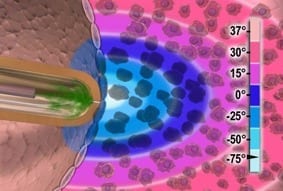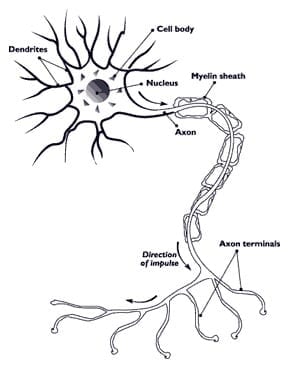
Cryoablation: Interventional radiologists present results of research on a new minimally invasive treatment option for advanced cancers that have spread to lung tissue
Highlights
- Minimally invasive cryoablation freezes and kills cancerous tumors that have spread to the lung, suggests first results of the ECLIPSE trial.
- Cryoablation was 100 percent effective after three months, researchers found.
- While not a cure, cryoablation appears to extend patient survival.
- Interventional radiologists are doctors who specialize in minimally invasive targeted treatments. They use X-rays, MRI or other imaging to guide a catheter inside the body, usually in an artery, to treat at the source of disease.
Frozen balls of ice can safely kill cancerous tumors that have spread to the lungs, according to the first prospective multicenter trial of cryoablation. The results are being
presented at the Society of Interventional Radiology’s 38th Annual Scientific Meeting in New Orleans.
“Cryoablation has potential as a treatment for cancer that has spread to the lungs from other parts of the body and could prolong the lives of patients who are running out of options,” said David A. Woodrum, M.D., Ph.D., an author of the study and interventional radiologist at the Mayo Clinic in Rochester, Minn. “We may not be able to cure the cancer, but with cryoablation we can at least slow it down significantly and allow patients to enjoy greater quality of life longer,” he added. Metastatic lung disease is difficult to treat and often signals a poor prognosis for patients.
In the initial results of the study, called the ECLIPSE trial (Evaluating Cryoablation of Metastatic Lung/Pleura Tumors in Patients—Safety and Efficacy), 22 subjects with a total of 36 tumors were treated with 27 cryoablation sessions. Cryoablation was 100 percent effective in killing those tumors at three-month follow-up. Follow-up at six months on 5 of the 22 patients (23 percent) showed the treated tumors to still be dead. Cryoablation is performed by an interventional radiologist using a small needle-like
probe guided through a nick in the skin to cancerous tumors inside the lung under medical imaging guidance. These tumors have spread—or metastasized—to the lung from primary cancers in other areas of the body. Once in position, the tip of the instrument is cooled with gas to as low as minus 100 degrees Celsius. The resulting halo of ice crystals can destroy cancer by interrupting its cellular function, protecting nearby healthy, delicate lung tissue. Lung cryoablation has been promising in part due to the low
periprocedural morbidity.
“Most of these patients can go home the day after their cryoablation treatment and resume their normal activities,” Woodrum said, noting that researchers plan to continue to follow patients for up to five years.
The Latest Bing News on:
Cryoablation
- Cryoablation Emerges Promising Treatment for Chronic Rhinitis: Systematic Review Reveals Potential Benefitson April 25, 2024 at 5:30 pm
ClariFix is a novel intranasal cryotherapy device developed for clinic-based cryosurgical posterior nasal nerve region ablation. As a relatively new technology, there is a lack of studies within the ...
- Cryoablation Presents a New Avenue for Breast Cancer Treatmenton April 25, 2024 at 3:00 am
Cryoablation (also called cryosurgery or cryotherapy) uses very low temperatures to freeze abnormal tissue, destroying it during freezing. A medical professional uses a cryoprobe, which is cooled with ...
- Cryoablation for Liver Tumors -- Is There Clinical Utility?on April 19, 2024 at 4:59 pm
The large majority of liver tumors are metastatic, of which colorectal deposits are the most common. Resection is the preferable mode of treatment because it offers the possibility of prolonged ...
- Cryoablation for Early-Stage Breast Cancer a Safe Option in Older Womenon April 15, 2024 at 10:26 am
ORLANDO -- Cryoablation without excision for low-risk, early-stage breast cancer may be an option for women over 60, 5-year follow-up results from the ICE3 trial showed. At a mean follow-up of 54. ...
- Cryoablation for Early-Stage Breast Cancer a Safe Option in Older Womenon April 14, 2024 at 5:00 pm
Opens in a new tab or window Share on LinkedIn. Opens in a new tab or window ORLANDO -- Cryoablation without excision for low-risk, early-stage breast cancer may be an option for women over 60 ...
- Cryoablation freezing technique may help treat large breast cancer tumorson April 14, 2024 at 5:00 pm
Share on Pinterest New research suggests cryoablation, which uses extreme cold to kill cancer cells, could help treat large breast cancer tumors. Boy_Anupong/Getty Images Breast cancer is the most ...
- Ultralow-Temperature Cryoablation Promising for Monomorphic VTon April 12, 2024 at 12:27 pm
BERLIN, Germany—Treatment of monomorphic ventricular tachycardia (VT) with a novel ultralow-temperature cryoablation catheter (vCLAS; Adagio Medical) appears to be safe and effective in patients with ...
- This Freezing Technique Could Be the Next Frontier in Breast Cancer Treatmenton April 11, 2024 at 5:00 pm
A freezing technique called cryoablation was shown to be 90 percent successful in eliminating cancerous breast tumors up to about an inch in diameter. Cryoablation is already used to treat smaller ...
- New, Less Invasive Breast Cancer Treatment Involving Freezing Could Replace Surgery for Some Patientson April 9, 2024 at 4:33 pm
The process, called cryoablation, uses imaging guidance such as ultrasound or a computed tomography (CT) scan to locate tumors, per a press release shared by the Society of Interventional ...
- This alternative to surgery may be the next frontier in breast cancer treatmenton April 9, 2024 at 10:44 am
Cryoablation, a minimally invasive technique, could provide a treatment alternative for patients who are not candidates for surgery, a press release stated. The study evaluated 60 patients who ...
The Latest Google Headlines on:
Cryoablation
[google_news title=”” keyword=”Cryoablation” num_posts=”10″ blurb_length=”0″ show_thumb=”left”] [/vc_column_text]The Latest Bing News on:
Cryoablation treatment
- Cryoablation Emerges Promising Treatment for Chronic Rhinitis: Systematic Review Reveals Potential Benefitson April 25, 2024 at 5:30 pm
ClariFix is a novel intranasal cryotherapy device developed for clinic-based cryosurgical posterior nasal nerve region ablation. As a relatively new technology, there is a lack of studies within the ...
- Cryoablation Presents a New Avenue for Breast Cancer Treatmenton April 25, 2024 at 3:00 am
A medical professional uses a cryoprobe, which is cooled with liquid nitrogen or compressed argon and pressed against the treatment area. Cryoablation does not require a cryoprobe; in some cases, a ...
- CHUM becomes first in Quebec to offer cryoablation for breast canceron April 16, 2024 at 5:01 pm
“We know that some patients with small tumours can potentially benefit from an approach that is less aggressive, with local treatment. Cryoablation of breast cancer is truly an alternative to ...
- Cryoablation for Early-Stage Breast Cancer a Safe Option in Older Womenon April 15, 2024 at 10:26 am
A patient who had cryoablation may need to remain with the group that performed the treatment to avoid unnecessary imaging." A 3-year interim analysis of the ICE3 trial showed that the ipsilateral ...
- Cryoablation freezing technique may help treat large breast cancer tumorson April 14, 2024 at 5:00 pm
A newer treatment called cryoablation, which uses extreme cold to kill cancer cells, has traditionally only been used to treat small breast cancer tumors. New research provides evidence that ...
- Page settingson April 13, 2024 at 7:08 am
A treatment using extreme cold has proven successful in destroying large tumors in people with breast cancer who are ineligible for surgery. The technique, called cryoablation, is already used to ...
- This Freezing Technique Could Be the Next Frontier in Breast Cancer Treatmenton April 11, 2024 at 5:00 pm
A freezing technique called cryoablation was shown to be 90 percent successful in eliminating cancerous breast tumors up to about an inch in diameter. Cryoablation is already used to treat smaller ...
- New, Less Invasive Breast Cancer Treatment Involving Freezing Could Replace Surgery for Some Patientson April 9, 2024 at 4:33 pm
The process, called cryoablation, uses imaging guidance such as ultrasound or a computed tomography (CT) scan to locate tumors, per a press release shared by the Society of Interventional ...
- New, Less Invasive Breast Cancer Treatment Involving Freezing Could Replace Surgery for Some Patientson April 9, 2024 at 4:33 pm
Researchers at Memorial Sloan Kettering Cancer Center conducted a study with 60 patients who received cryoablation treatment. Of those individuals, only a 10% recurrence at their 16-month follow ...
- This alternative to surgery may be the next frontier in breast cancer treatmenton April 9, 2024 at 10:44 am
Cryoablation, a minimally invasive technique, could provide a treatment alternative for patients who are not candidates for surgery, a press release stated. The study evaluated 60 patients who ...
The Latest Google Headlines on:
Cryoablation treatment
[google_news title=”” keyword=”cryoablation treatment” num_posts=”10″ blurb_length=”0″ show_thumb=”left”]










